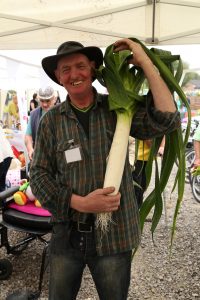Phil’s Guide to Cloning Leeks
 Phil’s leeks have come from a strain that was shown at Harrogate. This variety was crossed with elephant garlic to make it grow into huge leeks suitable for showing. However it still tastes of leek and not garlic. Although they are large they still taste very good. All Phil and Mary’s vegetables are grown organically and they’re not just for showing – they have to be good to eat too. Phil recommends cloning even if you’re not going to take your leeks to a show because you get a plant that you know has been grown successfully locally. Commercial seed may have been grown far away and might not like local conditions.
Phil’s leeks have come from a strain that was shown at Harrogate. This variety was crossed with elephant garlic to make it grow into huge leeks suitable for showing. However it still tastes of leek and not garlic. Although they are large they still taste very good. All Phil and Mary’s vegetables are grown organically and they’re not just for showing – they have to be good to eat too. Phil recommends cloning even if you’re not going to take your leeks to a show because you get a plant that you know has been grown successfully locally. Commercial seed may have been grown far away and might not like local conditions.
How to clone a leek:
- Keep back a good quality leek. Dig it up in September, trim back the roots and cut a third to half off the top.
- Plant the leek in multipurpose compost so it’s half buried.
- Keep it in a warmish greenhouse over winter or indoors.
- Plant it outside in open ground in May.
- The leek will flower in July or August the year after it was dug up. As soon as it flowers give it a haircut. All of a sudden it will grow hairs. Leave it until the hairs are easy to pull out and then plant the tiny leeks which are called ‘pips’. If the hairs aren’t ready and you expect a frost the parent plant can be dug up, planted in a pot and brought inside if necessary to protect from frosts while you’re waiting for the hairs.
- The pips can be potted on individually and the young leeks should be planted out after the frosts have finished.
- Save a couple of the best leeks for cloning and begin again!
Phil’s tips:
- Leeks should be planted in ground that hasn’t had manure or compost added. You can add these the year before but then don’t feed. This applies to onions too.
- Plant leeks as far away from garlic as possible. This is to prevent rust which often develops on garlic as the leaves die back. If leeks are growing nearby they’ll pick up the rust while they are still young.
- Collar leeks to get a long white stem. Damp-proof material is useful for excluding light and reflective material is useful to protect from heat in summer. As the leek grows you will need to replace the collar with a bigger one.
- Each leek flower can produce as many as two or three hundred pips. Only one or two leeks need to be overwintered to provide plenty of pips.
- When Phil plants leeks he makes a deep hole with a broom handle and drops the leek in. The hole is so deep only the tips of the leaves are showing above ground. He doesn’t add any soil just pours water into the hole and leaves nature to do its work.
- Your soil might be a bit different to Phil’s so you may need to experiment a little to get the best results
